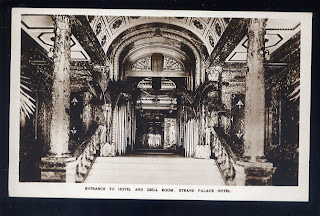Rectory of St Clement Danes,
House built on site by Thomas Palmer (died 1553)
1561 House extended
Extended by William Cecil [1520 - 1598]
1571 Cecil was created Lord Burghley, this London seat becomes known as Burghley House.
"It was a symmetrical double-courtyard brick house of three storeys, with four-storey corner turrets. A central entrance led from The Strand into the front court. At its garden front, with a central bay window and corner turrets, the house looked over gardens on grounds purchased from the Earl of Bedford and the earl's fields of Covent Garden beyond. The garden included a mount with a spiralling path to its top, a paved tennis court, a bowling alley and an orchard."
1598 The house becomes the residence of Burghley's elder son Thomas Cecil.
1605 Thomas Cecil created 1st Earl of Exeter.
His younger brotherRobert Cecil, 1st Earl of Salisbury, builds Salisbury House on the opposite side of the Strand.
1676 House converted into/demolished and replaced by Exeter Exchange


1817 Waterloo Bridge opened.
1829 Exeter Exchange Demolished
1831 Exeter Hall opens.
1907 Exeter Hall Demolished
1907. Strand Hotel Limited was incorporated on 31 October with some 4,000 shareholders. Created by the Salmon & Gluckstein families, it was established to fund the building of the Strand Palace Hotel.
1909 Strand Palace Hotel opens.
1922. J Lyons &Co acquired shares in this enterprise and also bought the adjoining Haxells family hotel in order to expand and improve the Strand hotel.
1928. After extensive redevelopment, the hotel became an art deco showcase, and reopened in boasting 980 bedrooms.
The rear of the property was occupied by the Winter Garden Restaurant.The Winter Garden restaurant had a large dome ceiling and could seat over 500 guests, which were served by over 100 staff.
Due to its large number of bedrooms, the hotel became popular with the American forces before they were sent into action. Indeed, the hotel was in fact commissioned as an official U.S rest and recuperation residence.
The post-war era saw the Strand Palace Hotel implement a number of improvements. With the introduction of private bathrooms in all guest rooms in 1958, reducing the number of rooms at the hotel to 786. The increased number of bathroom facilities meant oil-fired boilers had to be installed to cope with the demand for hot water.
1968. the front hall and ground floor restaurants, including the Winter Garden, were redesigned, and the first computerised billing system in London was installed.
The revolving doors designed by Oliver P. Bernard were removed in this redesign, but were of such fine quality and historic interest that curators at the Victoria and Albert Museum requested them for their collection.The doors were exhibited in 2003, in the museum's major exhibition 'Art Deco: 1910-1939' .
1976. Forte bought the lease for the Strand Palace Hotel from the Lyons Hotel Group.
1985. An in depth refurbishment was undertaken on all floors of the new hotel and this included new furniture, new bathrooms and a redecoration of the bedrooms.
2006. London and Regional Properties' took over the hotel.










No comments:
Post a Comment